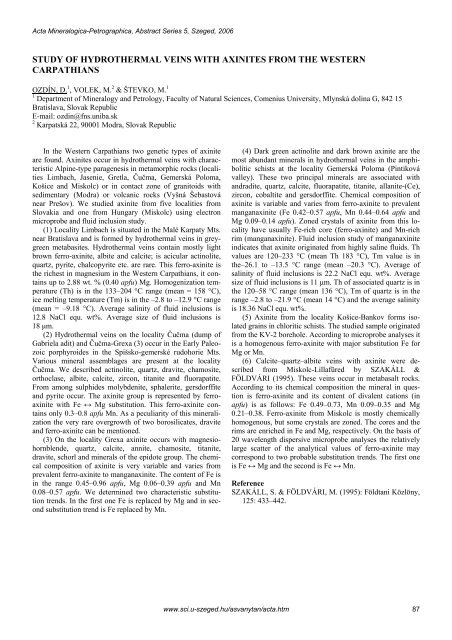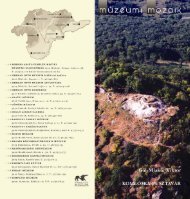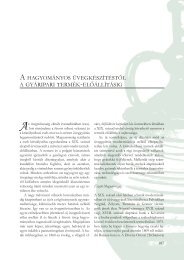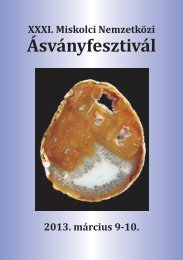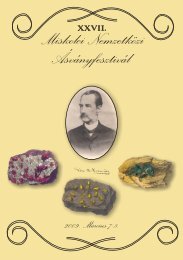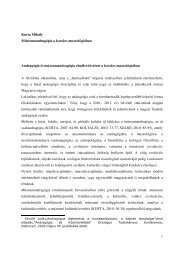Acta Mineralogica-Petrographica, Abstract Series 5, Szeged, 2006EXPERIMENTAL ALTERATION OF VOLCANIC GLASSOSACKÝ, M. 1 , UHLÍK, P. 1 & KUCHTA, Ľ. 21 Department of Geology of Mineral Deposits, Faculty of Natural Sciences, Comenius University; 842 15 Bratislava, SlovakiaE-mail: osacky@fns.uniba.sk2 Department of Inorganic Chemistry, Faculty of Natural Sciences, Comenius University; 842 15 Bratislava, SlovakiaExperimental alteration of volcanic glass by variable concentrationsof NaOH, NaOH + KOH, HCl was carried out at70 °C for 25, 28, 50 days and at 150 °C, for 10 and 20 days.The products were examined by X-ray powder diffraction(XRD), infrared spectroscopy, scanning electron microscopy(SEM) and energy dispersive X-ray spectrometry (EDS).Experimental alteration was performed using an obsidianfrom Viničky and a perlite from Lehôtka pod Brehmi as startingmaterials. It was confirmed by XRD that starting perlitefrom Lehôtka pod Brehmi contained biotite, albite, quartzand smectite. Some of these minerals were observed by microscopicobservation too. However uncrystalline glassyphase was predominated in obsidian from Viničky.Experiments at 70 °C were carried out in closed PVC bottleswith 5 g (grain size < 0.16 mm) and 2 g (grain size10 µm) of the starting material in contact with 100 ml of11.7 pH NaOH + KOH solution (NaOH/KOH ratio 1:1).Duration of experiments were 28 days. The experiments at70 °C were carried out in opened bottles with 2 g (grain size10 µm) of the starting material in contact with 20 ml of 11.7or 7.7 pH NaOH + KOH solution (NaOH/KOH ratio 1:1) and4.5 pH HCl solution. After transpiration of reaction solution20 ml of distilled water was added (50 or 100 time) to volcanicglass. Duration of experiments were 25 and 50 days.Experiments at 150 °C were conducted in teflon bottlescontaining 200 mg of starting material and 40 ml of 1 MNaOH or KOH solution, or 150 mg of starting material and30 ml of 1 M NaOH or KOH solution. Each bottle wasplaced in an autoclave and was kept at 150 °C for 10 and 20days.XRD patterns of all volcanic glasses after low temperatureexperiments (70 °C) showed decrease of diffractionpeaks of original minerals (Fig. 1a). Slight dissolution ofvolcanic glass was documented by elliptical micrometersizedetch pits on the surface of volcanic glass grains. For the150 °C experiment with 1 M NaOH solution, aggregates ofphillipsite appeared initially after 10 days (Fig 1b). Analcimeand albite were the most abundant reaction products using1 M NaOH solution after 20 days (Fig 1b).The results of experimental alteration of obsidian fromViničky in the present study fit well with diagenetic alterationsof volcanic glass in the East Slovak Basin (ŠAMA-JOVÁ, 1997).ReferenceŠAMAJOVÁ, E. (1997): In: KIROV, G. N., FILIZOVA, L.& PETROV, O. (eds.) Natural Zeolites – Sofia ’95, Sofia– Moscow: Pensoft Publishers, 215–226.Fig. 1a: XRD pattern of the starting perlite from Lehôtka pod Brehmi (A), XRD pattern of perlite after experiment at 70 °C for28 days in 11,7 pH NaOH + KOH solution (B). Ab = albite, Bt = biotite, Q = quartz.Fig. 1b: XRD patterns of reaction products formed from obsidian from Viničky by reaction at 150 °C, for 10 days (C) and 20days (D) in 1 M NaOH solution. P = phillipsite, A = analcime, Ab = albite.86www.sci.u-szeged.hu/asvanytan/acta.htm
Acta Mineralogica-Petrographica, Abstract Series 5, Szeged, 2006STUDY OF HYDRO<strong>THE</strong>RMAL VE<strong>IN</strong>S WITH AX<strong>IN</strong>ITES FROM <strong>THE</strong> WESTERN<strong>CARPATHIANS</strong>OZDÍN, D. 1 , VOLEK, M. 2 & ŠTEVKO, M. 11 Department of Mineralogy and Petrology, Faculty of Natural Sciences, Comenius University, Mlynská dolina G, 842 15Bratislava, Slovak RepublicE-mail: ozdin@fns.uniba.sk2 Karpatská 22, 90001 Modra, Slovak RepublicIn the Western Carpathians two genetic types of axiniteare found. Axinites occur in hydrothermal veins with characteristicAlpine-type paragenesis in metamorphic rocks (localitiesLimbach, Jasenie, Gretla, Čučma, Gemerská Poloma,Košice and Miskolc) or in contact zone of granitoids withsedimentary (Modra) or volcanic rocks (Vyšná Šebastovánear Prešov). We studied axinite from five localities fromSlovakia and one from Hungary (Miskolc) using electronmicroprobe and fluid inclusion study.(1) Locality Limbach is situated in the Malé Karpaty Mts.near Bratislava and is formed by hydrothermal veins in greygreenmetabasites. Hydrothermal veins contain mostly lightbrown ferro-axinite, albite and calcite; is acicular actinolite,quartz, pyrite, chalcopyrite etc. are rare. This ferro-axinite isthe richest in magnesium in the Western Carpathians, it containsup to 2.88 wt. % (0.40 apfu) Mg. Homogenization temperature(Th) is in the 133–204 °C range (mean = 158 °C),ice melting temperature (Tm) is in the –2.8 to –12.9 °C range(mean = –9.18 °C). Average salinity of fluid inclusions is12.8 NaCl equ. wt%. Average size of fluid inclusions is18 µm.(2) Hydrothermal veins on the locality Čučma (dump ofGabriela adit) and Čučma-Grexa (3) occur in the Early Paleozoicporphyroides in the Spišsko-gemerské rudohorie Mts.Various mineral assemblages are present at the localityČučma. We described actinolite, quartz, dravite, chamosite,orthoclase, albite, calcite, zircon, titanite and fluorapatite.From among sulphides molybdenite, sphalerite, gersdorffiteand pyrite occur. The axinite group is represented by ferroaxinitewith Fe ↔ Mg substitution. This ferro-axinite containsonly 0.3–0.8 apfu Mn. As a peculiarity of this mineralizationthe very rare overgrowth of two borosilicates, draviteand ferro-axinite can be mentioned.(3) On the locality Grexa axinite occurs with magnesiohornblende,quartz, calcite, annite, chamosite, titanite,dravite, schorl and minerals of the epidote group. The chemicalcomposition of axinite is very variable and varies fromprevalent ferro-axinite to manganaxinite. The content of Fe isin the range 0.45–0.96 apfu, Mg 0.06–0.39 apfu and Mn0.08–0.57 apfu. We determined two characteristic substitutiontrends. In the first one Fe is replaced by Mg and in secondsubstitution trend is Fe replaced by Mn.(4) Dark green actinolite and dark brown axinite are themost abundant minerals in hydrothermal veins in the amphiboliticschists at the locality Gemerská Poloma (Pintikovávalley). These two principal minerals are associated withandradite, quartz, calcite, fluorapatite, titanite, allanite-(Ce),zircon, cobaltite and gersdorffite. Chemical composition ofaxinite is variable and varies from ferro-axinite to prevalentmanganaxinite (Fe 0.42–0.57 apfu, Mn 0.44–0.64 apfu andMg 0.09–0.14 apfu). Zoned crystals of axinite from this localityhave usually Fe-rich core (ferro-axinite) and Mn-richrim (manganaxinite). Fluid inclusion study of manganaxiniteindicates that axinite originated from highly saline fluids. Thvalues are 120–233 °C (mean Th 183 °C), Tm value is inthe–26.1 to –13.5 °C range (mean –20.3 °C). Average ofsalinity of fluid inclusions is 22.2 NaCl equ. wt%. Averagesize of fluid inclusions is 11 µm. Th of associated quartz is inthe 120–58 °C range (mean 136 °C), Tm of quartz is in therange –2.8 to –21.9 °C (mean 14 °C) and the average salinityis 18.36 NaCl equ. wt%.(5) Axinite from the locality Košice-Bankov forms isolatedgrains in chloritic schists. The studied sample originatedfrom the KV-2 borehole. According to microprobe analyses itis a homogenous ferro-axinite with major substitution Fe forMg or Mn.(6) Calcite–quartz–albite veins with axinite were describedfrom Miskolc-Lillafüred by SZAKÁLL &FÖLDVÁRI (1995). These veins occur in metabasalt rocks.According to its chemical composition the mineral in questionis ferro-axinite and its content of divalent cations (inapfu) is as follows: Fe 0.49–0.73, Mn 0.09–0.35 and Mg0.21–0.38. Ferro-axinite from Miskolc is mostly chemicallyhomogenous, but some crystals are zoned. The cores and therims are enriched in Fe and Mg, respectively. On the basis of20 wavelength dispersive microprobe analyses the relativelylarge scatter of the analytical values of ferro-axinite maycorrespond to two probable substitution trends. The first oneis Fe ↔ Mg and the second is Fe ↔ Mn.ReferenceSZAKÁLL, S. & FÖLDVÁRI, M. (1995): Földtani Közlöny,125: 433–442.www.sci.u-szeged.hu/asvanytan/acta.htm 87
- Page 1:
MSCC33 rd MINERAL SCIENCES IN THE C
- Page 5 and 6:
Acta Mineralogica-Petrographica, Ab
- Page 7 and 8:
Acta Mineralogica-Petrographica, Ab
- Page 9 and 10:
Acta Mineralogica-Petrographica, Ab
- Page 11 and 12:
Acta Mineralogica-Petrographica, Ab
- Page 13 and 14:
Acta Mineralogica-Petrographica, Ab
- Page 15 and 16:
Acta Mineralogica-Petrographica, Ab
- Page 17 and 18:
Acta Mineralogica-Petrographica, Ab
- Page 19 and 20:
Acta Mineralogica-Petrographica, Ab
- Page 21 and 22:
Acta Mineralogica-Petrographica, Ab
- Page 23 and 24:
Acta Mineralogica-Petrographica, Ab
- Page 25 and 26:
Acta Mineralogica-Petrographica, Ab
- Page 27 and 28:
Acta Mineralogica-Petrographica, Ab
- Page 29 and 30:
Acta Mineralogica-Petrographica, Ab
- Page 31 and 32:
Acta Mineralogica-Petrographica, Ab
- Page 33 and 34:
Acta Mineralogica-Petrographica, Ab
- Page 35 and 36: Acta Mineralogica-Petrographica, Ab
- Page 37 and 38: Acta Mineralogica-Petrographica, Ab
- Page 39 and 40: Acta Mineralogica-Petrographica, Ab
- Page 41 and 42: Acta Mineralogica-Petrographica, Ab
- Page 43 and 44: Acta Mineralogica-Petrographica, Ab
- Page 45 and 46: Acta Mineralogica-Petrographica, Ab
- Page 47 and 48: Acta Mineralogica-Petrographica, Ab
- Page 49 and 50: Acta Mineralogica-Petrographica, Ab
- Page 51 and 52: Acta Mineralogica-Petrographica, Ab
- Page 53 and 54: Acta Mineralogica-Petrographica, Ab
- Page 55 and 56: Acta Mineralogica-Petrographica, Ab
- Page 57 and 58: Acta Mineralogica-Petrographica, Ab
- Page 59 and 60: Acta Mineralogica-Petrographica, Ab
- Page 61 and 62: Acta Mineralogica-Petrographica, Ab
- Page 63 and 64: Acta Mineralogica-Petrographica, Ab
- Page 65 and 66: Acta Mineralogica-Petrographica, Ab
- Page 67 and 68: Acta Mineralogica-Petrographica, Ab
- Page 69 and 70: Acta Mineralogica-Petrographica, Ab
- Page 71 and 72: Acta Mineralogica-Petrographica, Ab
- Page 73 and 74: Acta Mineralogica-Petrographica, Ab
- Page 75 and 76: Acta Mineralogica-Petrographica, Ab
- Page 77 and 78: Acta Mineralogica-Petrographica, Ab
- Page 79 and 80: Acta Mineralogica-Petrographica, Ab
- Page 81 and 82: Acta Mineralogica-Petrographica, Ab
- Page 83 and 84: Acta Mineralogica-Petrographica, Ab
- Page 85: Acta Mineralogica-Petrographica, Ab
- Page 89 and 90: Acta Mineralogica-Petrographica, Ab
- Page 91 and 92: Acta Mineralogica-Petrographica, Ab
- Page 93 and 94: Acta Mineralogica-Petrographica, Ab
- Page 95 and 96: Acta Mineralogica-Petrographica, Ab
- Page 97 and 98: Acta Mineralogica-Petrographica, Ab
- Page 99 and 100: Acta Mineralogica-Petrographica, Ab
- Page 101 and 102: Acta Mineralogica-Petrographica, Ab
- Page 103 and 104: Acta Mineralogica-Petrographica, Ab
- Page 105 and 106: Acta Mineralogica-Petrographica, Ab
- Page 107 and 108: Acta Mineralogica-Petrographica, Ab
- Page 109 and 110: Acta Mineralogica-Petrographica, Ab
- Page 111 and 112: Acta Mineralogica-Petrographica, Ab
- Page 113 and 114: Acta Mineralogica-Petrographica, Ab
- Page 115 and 116: Acta Mineralogica-Petrographica, Ab
- Page 117 and 118: Acta Mineralogica-Petrographica, Ab
- Page 119 and 120: Acta Mineralogica-Petrographica, Ab
- Page 121 and 122: Acta Mineralogica-Petrographica, Ab
- Page 123 and 124: Acta Mineralogica-Petrographica, Ab
- Page 125 and 126: Acta Mineralogica-Petrographica, Ab
- Page 127 and 128: Acta Mineralogica-Petrographica, Ab
- Page 129 and 130: Acta Mineralogica-Petrographica, Ab
- Page 131 and 132: Acta Mineralogica-Petrographica, Ab
- Page 133 and 134: Acta Mineralogica-Petrographica, Ab


